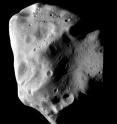Fascinating images from a new world
Related images
(click to enlarge)
With a resolution of around 60 metres per pixel, the images provide a fascinating view of Lutetia. "This is a completely new world, which no-one has ever seen before," says Max Planck researcher Holger Sierks, Head of the OSIRIS team. The planetoid, whose longest axis measures around 126 kilometres, is oval in shape. Its surface is marked by many craters, both large and small; in one of the larger craters, the images even show evidence of a landslide. In some parts, parallel grooves cover the cosmic rock, the origin of which is still unknown. The camera system had already focused on the asteroid on Saturday morning. At approximately 6 p.m. the Rosetta space probe was within 3,162 kilometres of the asteroid. "Both the wide-angle and the telephoto camera worked perfectly," reports Sierks. The Control Centre of the European Space Agency ESA passed the data collected during the fly-by directly to the Max Planck Institute, where researchers worked all day and into the night filtering images from the raw data. On Saturday at around 11 p.m. they presented their initial results.
During the coming days and weeks the scientists want to further evaluate the images. It should then be possible to determine the colour of the asteroid and thus the chemical composition of its surface in more detail. They will also use data from other measuring instruments which were active during the fly-by as well.
Since 2004, the Rosetta space probe has been en route to the Churyumov/Gerasimenko comet, and the plan is for the Philae lander to touch down on the comet in 2014. In September 2008, Rosetta passed the planetoid Steins.
Source: Max-Planck-Gesellschaft
Other sources
- Fascinating images from a new world: Close-ups of the asteroid Lutetiafrom Science DailyWed, 14 Jul 2010, 17:35:43 UTC
- Fascinating images from a new worldfrom Science BlogWed, 14 Jul 2010, 14:49:20 UTC
- Fascinating images from a new worldfrom PhysorgWed, 14 Jul 2010, 14:35:20 UTC

